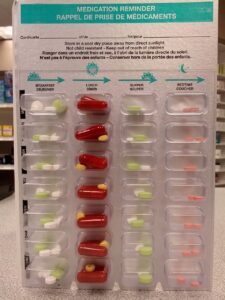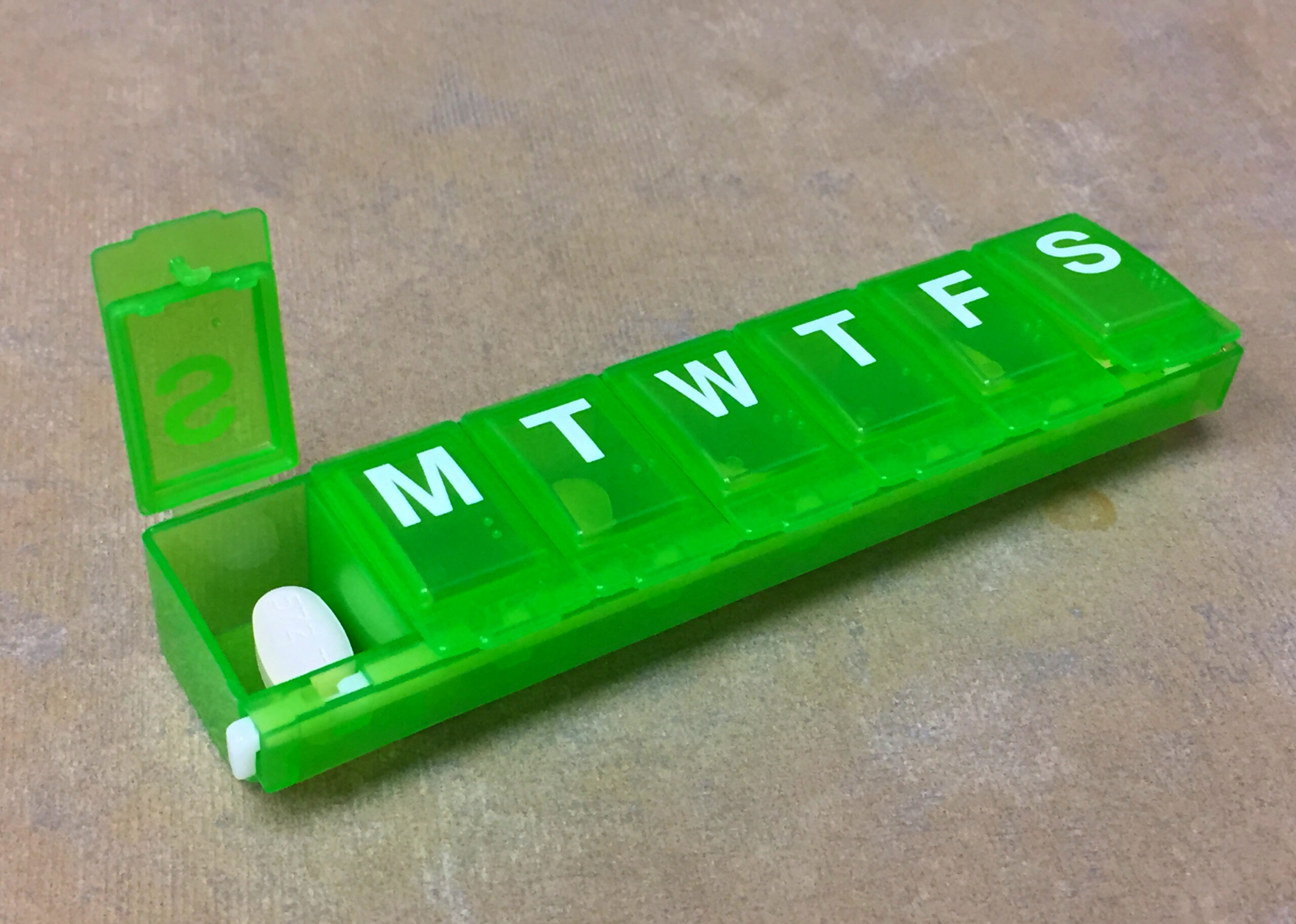12.4 General Procedures for Medication Assistance and Administration
There are consistent steps that must be followed no matter what kind of medication is required. In addition, when medication administration has been delegated, each type of medication will include additional steps to be followed. These steps will be listed in the medication procedure and care plan provided by the agency.
General steps to follow each time you perform medication assistance or medication administration are outlined below:
- Read the care plan carefully to ensure you know what type of medication care activity is being requested (task or restricted activity), directions specific for the client and the procedure specific to the type of medication.
- Discuss the care activity with the client prior to beginning and ensure they are in a comfortable position. Remember, the client always has the right to refuse any care activity.
- Gather all the supplies that you will need and verify what you will be doing with the care plan and the blister pack or medication container.
- Complete the three medication safety checks while checking that you have the following:
- Right client
- Right medication
- Right time
- Right dose
- Right route
- Right documentation
- Ensure your hands and the client’s hands (for medication assistance) are clean.
- Perform the medication care activity according to the specific steps in the care plan.
- Document on the appropriate agency documentation form that the care activity was completed. If the care activity was not completed, ensure you document this as well.
- Report to the supervisor or RN as needed.
Routes of Administration and Assisting with Medications
Medications can come in many different forms. No matter which form the medication is in, the HCA can only participate in medication care activities for prescribed medications that are listed in the care plan and medication administration record. Should a client ask the HCA to assist with medications not listed, including over-the-counter (OTC) medication or alternative remedies/complementary medications, do not proceed and instead notify the agency supervisor.
The different forms of medication are listed below.
Oral
- Oral medication is taken by mouth and swallowed.
- Can be solid (pills or capsules) or liquid.
- HCAs do not crush medications.
- Liquid medications must be in a pre-measured single-dose container from pharmacy.
Sublingual
- Sublingual refers to medication that is absorbed through the lining of the mouth and under the tongue.
- It could be provided in pill or spray form.
Eye Medication
- Eye medication can be supplied in drops or ointment.
- It may be necessary to clean the eye area before giving the medication.
- If drops are stored in the fridge, warm to room temp before instilling.
- Blurring of vision may be present for a short time after the medication is given.
Ear Drops
- Ear drops should be at room temperature to prevent dizziness as internal ear structures are very sensitive to temperature extremes.
- The tip of the dropper should not touch the skin to help prevent infection from occurring.
- The tip of the dropper must not cover the ear canal as this can cause increased pressure in the ear and can cause injury to the ear drum.
Inhaled Medications
- Medications in the form of aerosol spray, mist, or fine powder are inhaled through the mouth directly to the lungs.
- Metered dose inhalers (MDI) deliver a specific pre-set amount of medication to the lungs during inhalation. They come in two forms:
- Without spacer/chamber – requires coordination of breathing with delivery of medication.
- With spacer/chamber – no coordination of breathing required, makes it easier to inhale medication within the chamber with two to three breaths.
- Small volume nebulizers:
- Provide medications in an aerosolized form that is inhaled into the lungs.
- Coordination of breathing and medications delivery is not required.
Topical Medications
Before applying any type of topical medication, skin must be clean. The different types of topical medications are listed below:
Medicated lotions, creams, and ointments:
- Wear gloves when applying. Lotions, creams, and ointments can be absorbed through the skin of hands.
- Read the care plan to ensure you understand exactly where the product is to be applied. If this is not clear contact the RN.
- It is important to pay attention to the amount of the product used.
Transdermal patches
- These are adhesive pads that are placed on the skin so that the drug is absorbed slowly through the skin
- Rotation of the site is needed to reduce skin irritation
Vaginal applications
- May be delivered in different preparations, including foam, jelly, cream or suppository
Rectal applications
- May be delivered as a suppository or pre-packaged enema.
Subcutaneous Injections
- For subcutaneous injections, the medication is delivered via an injection into the fatty tissue beneath the skin
- Insulin is delivered via subcutaneous injections. However, HCAs do not perform injections, including adjusting the dosage on insulin pens.
Medication Delivery

Health Care Assistants must always follow the laws and guidelines established by B.C.’s Ministry of Health when it comes to medication assistance and administration. These laws and guidelines are explained in the 2023 HCA Program Provincial Curriculum. Additionally, HCAs must follow the health authority or agency policies for medication administration and assistance. In most complex care settings, HCAs will only assist the regulated health professional with the administration of medications such as topical creams/ointments and rectal suppositories/enemas. When working in assisted living, group homes, or home support, HCAs will participate more often in both medication assistance and medication administration, as per the limitations set in the HCA Program Provincial Curriculum (2023). When working in these settings, some clients will require the use of a lockbox (see Figure 12.4.1) for their medications. The need for a lockbox in the client’s home will be assessed by the RN, who will advise the client/family on what items to purchase. Medication lockboxes will have either a combination or keyed lock on them. Directions for accessing medications in these lockboxes should be provided in the clients care plan as per the agency guidelines.
Pharmacists often pre-package oral medications into daily doses for ease of use for clients. These pre-packaged medications come in the form of blister packs like the one in Figure 12.4.2. Other packages that HCAs may see include weekly pill dispensers to help the client know which day to take their medications (see Figure 12.4.3).
 |
 |
Administration Procedures
The following videos produced by Alberta Health Services for their Medication Assistance Program (MAP) show the procedures for each type of medication.
It is important to note that regulations regarding medications vary between the provinces and the following videos were made for an Alberta context. For HCAs working in British Columbia, medication assistance only includes activities that support the client in taking their own medication (self-administering). If the HCA is applying a cream or patch, squeezing in eye or ear drops, or inserting a suppository they are administering the medication, not assisting with medication. Therefore, in a B.C. context, the videos below would be considered medication administration, not medication assistance.
- Transdermal Patch (63) MAP Module 3 – YouTube
- Topical Medications (63) MAP Module 4 – YouTube
- Eye Medications (63) MAP Module 5 – YouTube
- Ear Medications (63) MAP Module 6 – YouTube
Learning Activity: Medication Assistance for Clients with Dementia (MAP Module 10)
In the following video, the home care nurse demonstrates two different approaches to working with a client with dementia who is distressed. As you watch the video, consider the reflection questions included in the video and how you might handle a similar situation.
If you were the caregiver in this situation, when would you have completed the medication safety checks and rights? How would you maintain the positive connection with the client while completing the necessary safety protocols?
Medication that does not require a prescription and is taken to treat minor health problems at home.
A variety of treatments and remedies used in addition to traditional Western medicine. They include herbal or natural products available over-the-counter, such as St. John’s Wort, ginseng, or melatonin.

